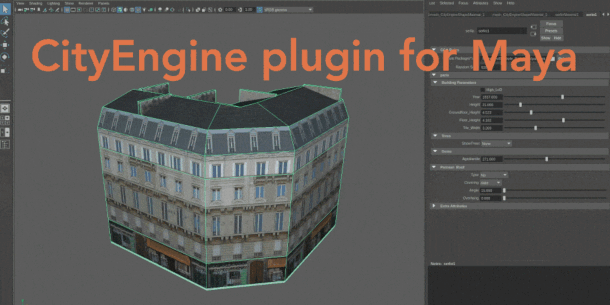Esri ships CityEngine 2019.1
Esri has released CityEngine 2019.1, the latest version of the procedural 3D city-generation software, along with Serlio, a new Maya integration plugin.
Serlio enables environment artists to edit buildings generated in CityEngine inside Maya, using the same procedural rules as within CityEngine itself.
New features in the core software include a dedicated new guide creation tool, improved 2D drawing workflows, updates to the Unreal Studio and SPLK exporters, and better integration with ArcGIS Urban.
A powerful procedural tool for generating 3D city models for urban planning and VFX
CityEngine generates detailed city models from simple procedural rules, importing data in standard file formats like OBJ and DXF, and exporting in formats including FBX and Alembic.
Although aimed at architects and urban planners – it integrates with ESRI’s ArcGIS platform – the software is also designed for entertainment, and comes with connections to DCC tools and game engines.
In recent years, it has been used on some major movies: Scanline VFX used it for city-destruction shots in Independence Day: Resurgence, and Walt Disney Animation Studios used it on Zootopia.

Serlio: new integration plugin lets artists edit CityEngine models procedurally inside Maya
For entertainment artists, the key change in CityEngine 2019.1 will be Serlio, the new Maya integration plugin.
Speaking to CG Channel earlier this year, Esri described it as a replacement for the old unofficial PRT4MAYA plugin, “implement[ed] properly with more capabilities”.
It works in a similar way for CityEngine models as Houdini Engine does for Houdini HDA files, making it possible to edit them directly in Maya using the same procedural rules as in the parent software.
Possible use cases include enabling environment artists to generate buildings rapidly in Maya by modifying a procedural template that has been created in CityEngine.
In addition, CityEngine’s Unreal Studio exporter now writes shaders, making it possible to import assets directly into an Unreal Studio project without using the old CityEngine Model Loader template.
Improvements to 2D drawing workflow and new dedicated tool for creating 3D guides
The 2D drawing tools, used for setting out the basic footprint of a building, and a focus of CityEngine 2019.0, get a further update, including a number of workflow improvements and bugfixes.
In addition, 3D guides – previously a feature of individual drawing tools – are now available via a centralised tool in the main menu and hotbar.
They work in a similar way to those in 2D drawing applications, providing guidelines to snap edges to.
In CityEngine 2019.1, their appearance has been updated to help them stand out from the background, and to shine through geometry at intersections. Guides also now support CityEngine’s Planar drawing mode.
Better integration with ArcGIS Urban, plus updates to I3S export
Urban planners also get the option to access and edit content created in ArcGIS Urban, Esri’s city planning solution, directly inside CityEngine.
The software’s SPLK exporter now writes version 1.7 of I3S, Esri’s open standard for streaming large volumes of 3D content across exterprise systems, adding support for PBR materials, and reducing loading times.
Pricing and availability
CityEngine 2019.1 is available for 64-bit Windows 7+ and Server 2008+, RHEL 7 Linux and macOS 10.13-10.14.
Esri doesn’t list prices directly on its website: when we checked on the release of version 2019.0, the firm told us that pricing varies from country to country, according to local distributors.
Serlio is available for Maya 2018 and 2019, running on Windows, Linux and macOS.
The plugin is free for non-commercial use. Commercial use requires “at least one commercial license of the latest CityEngine version installed in the organisation”.
Read an overview of the new features in CityEngine 2019.1
Read a full list of new features in CityEngine 2019.1 in the online changelog
